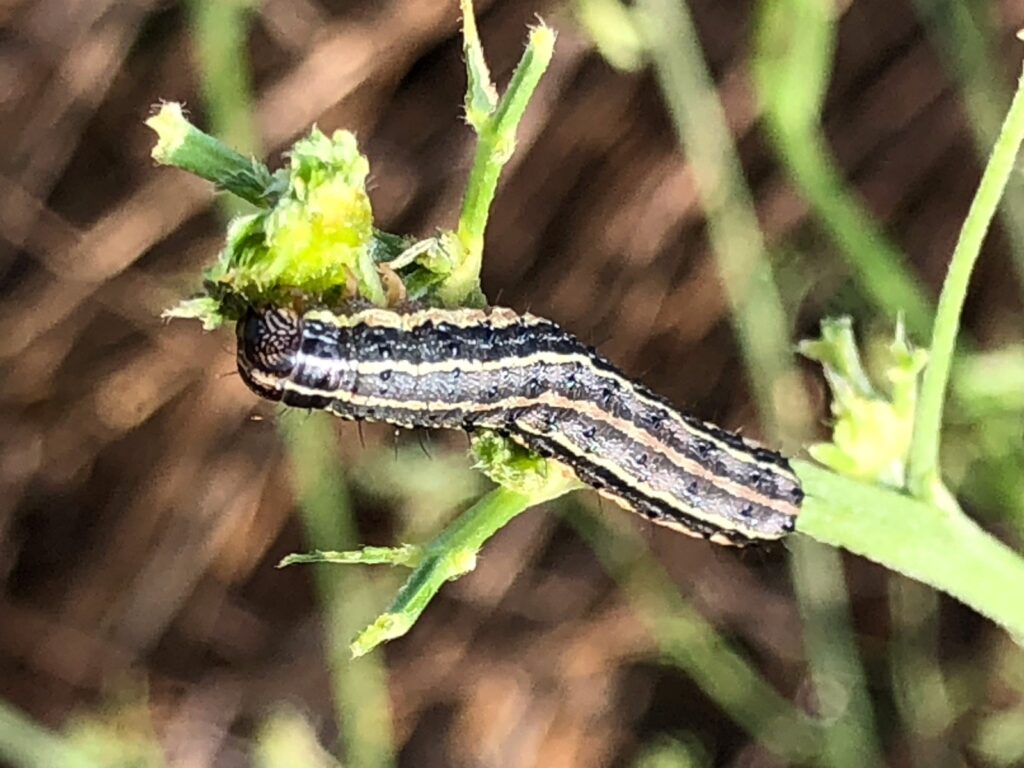Several reports of fields with fall armyworm (FAW) larvae have been coming in over the last few days. Growers or scouts drive by a field and pull over, shocked to see only stems left of plants with larvae happily feeding. So far most of the damage has been found in oats, rye cover crop, mixed forages and newly seeded cereals. This pest overwinters in the southern US, Mexico and Central and South America. Moths migrates up to this area in late summer and are typically light or arrive too late to be of concern. Not this year, apparently. The Great Lakes Region and other states are finding significant populations of larvae in some host crops. Damage is usually not spotted until the larvae are larger and are in their most hungry stages (4th – 6th instars). Unfortunately from the calls so far in Ontario, the larvae have been too big (larger than 1 inch) for insecticides to be effective but thankfully these larger larvae won’t be feeding much longer before they start to pupate.

Fall armyworm vary in colour from tan to almost black and have three white stripes along their back. If you look closely, you can see hairs coming out of “warts” along their body and they have an inverted white Y on their black “face” (Figure 1). Fall armyworm feed on grassy crops just like true armyworm do but FAW can also feed on some broadleaf plants like alfalfa and clover and some weeds like pigweed and fleabane (could they just stick to the weeds please?). Similar to true armyworm, they can do a lot of feeding in just a matter of days, marching from host field to host field.
Scouting is advised for any of their potential host crops to determine if they are present including corn, sorghum, cereals, mixed forages and cereal cover crops. The younger the crop, the more appealing it likely was for moths to lay eggs in. FAW larvae can be found feeding during the day. Scout at least 10 areas of the field, first starting at the edge of the fields that may be adjacent to other host crops. Patches of thinning stand is also a potential sign of feeding activity and should be investigated. Take note of the size of larvae that are found. If most of the larvae are 1 inch or larger, it is too late to control them but early harvest can save some crops from further damage. Larvae this large will be stop feeding soon and will go into pupation.
Corn: Scout for larvae in the ears in several areas of the field. It is too late to spray them in corn but if found, these fields should be scheduled for early harvest to reduce the risk of ear mould development. If possible, segregate grain from these infested areas of the field from the cleaner areas of the field. Some Bt traits do control FAW but should still be scouted to determine how effective they are at providing protection. FAW has been developing resistance to some of the Bt traits. The Canadian Bt Trait Table can be found here: https://fieldcropnews.com/wp-content/uploads/2021/04/Modified-Bt-Table-for-April-2021-English-V2.pdf
Cereals: The threshold for cereals is 4 or more larvae per 30 cm by 30 cm area. If larvae are smaller than 1 inch, products registered for FAW can be found here: http://www.omafra.gov.on.ca/english/crops/pub812/pub812ch4.pdf
If larvae are too big to manage (1 inch or larger) but you still need a cereal crop in that field, wait at least 2 weeks after larval feeding has stopped before replanting to reduce the risk to the new seedlings.
Forages: The threshold for forages is 5 or more larvae (smaller than 1 inch) per 30 cm by 30 cm area. If larvae are 1 inch or larger, insecticides will not be effective. Products registered for armyworm on forages can be found here: http://www.omafra.gov.on.ca/english/crops/pub812/pub812ch3.pdf Cutting/harvesting the crop is an option to keep the larvae from taking more of the crop. Take into consideration the critical fall resting period for alfalfa before cutting (map of critical dates here) to determine if cutting is more of a risk than losing this stand to FAW. Make sure to rake and bail it as soon as possible to avoid further larval feeding after harvest.
Cover Crops: If significant feeding has taken out the cover crop stand and reseeding is desired, wait at least 2 weeks before planting to ensure the larvae are no longer actively feeding.
Soybeans and Dry Beans: FAW could potentially feed on soybeans and dry beans, especially if they are adjacent to cereals or forages. However, given the crop stages these are at, there is no economic benefit to control them. It is too close to harvest for most of the beans that preharvest intervals would be reached already. For very late planted soybeans that are not nearing R6 yet, you could follow the defoliation thresholds which for R4 and R5 stages are 25% defoliation. But if the larvae are 1 inch or larger, the insecticides won’t effectively control them. The bigger the larvae, the closer they are to finishing their feeding and going into pupal stage. Harvest these crops as soon as they are ready to shorten the time these larvae have to feed on the plants.